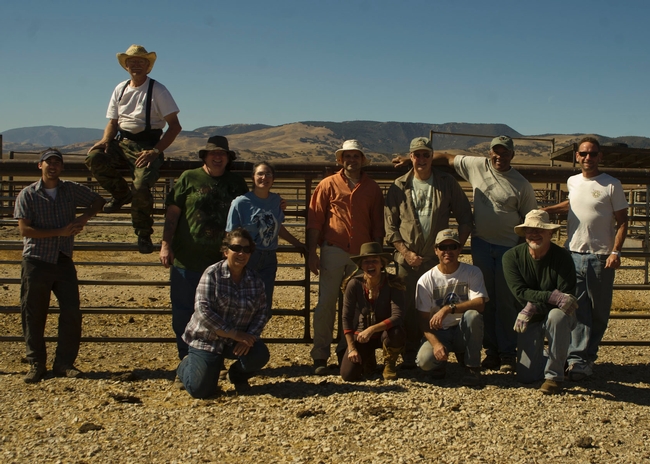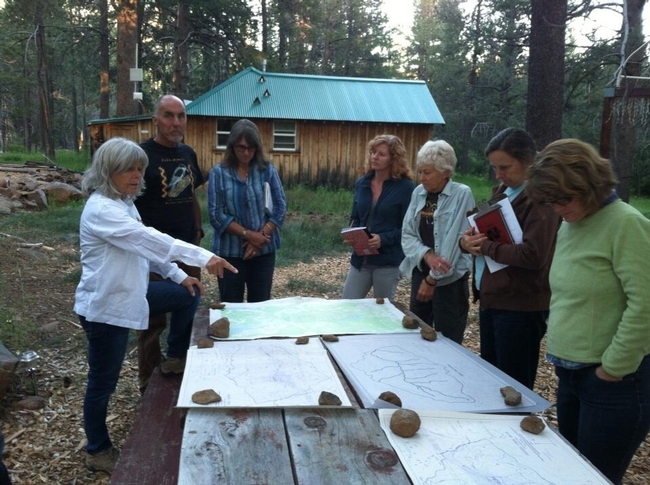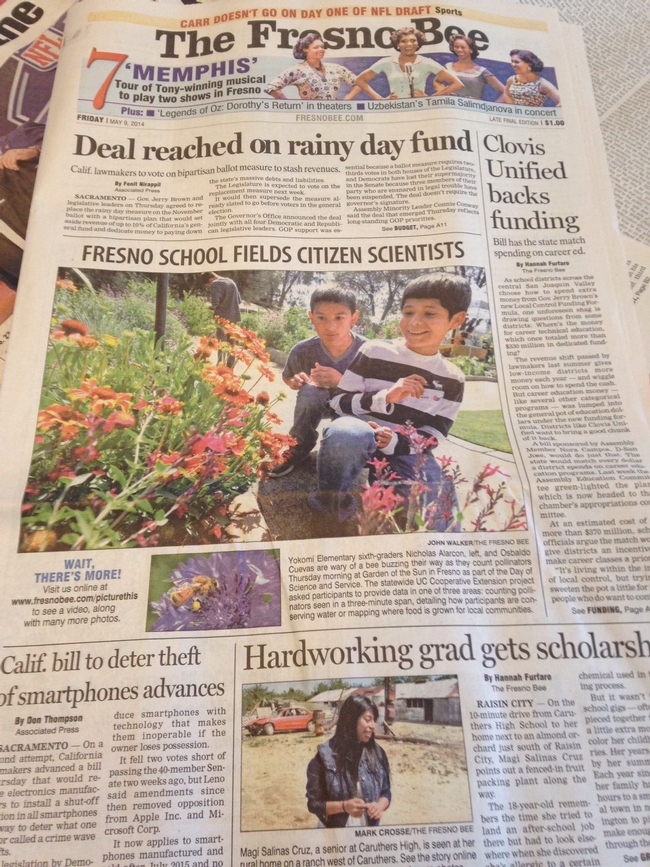Posts Tagged: centennial
Bakersfield gets a 'First Look' at UCCE centennial celebration
Brian Marsh, the director of UC Cooperative Extension in Kern County, talked about the upcoming UCCE centennial celebration with host Scott Cox on First Look, a web video and radio program that provides Kern County resident with an overview of the day's news. The program is broadcast on the Bakersfield Californian webpage and on KERN radio.
At a dinner Aug. 21 marking the 100th anniversary of UC Cooperative Extension, the organization will honor 14 Kern County families with a farming legacy that stretches back 100 years or more. Cox was impressed.
"For a family farm to be in business for 100 years, it's a tough way to make a living," Cox said. "There's a lot of temptation for kids to go off to school and learn how to do something else and sell the farm off. These are people who have stuck it out."
Marsh said the farming underway today is different than 100 years ago.
"The children are coming back to the farm with advanced degrees," Marsh said. "Farming isn't the simple life. .. There is a lot of technology, there's a lot of regulations to deal with. A lot of our products are exported, so you're dealing with international trade and residue concentrations in other countries."
Cox agreed. "From agribusiness, to science, there's a lot going on out there."
Marsh emphasized the importance of the California farming industry. "I like to eat everyday," he said.
State senator congratulates Tehama County UCCE
California State Sen. Jim Nielsen presented a senate resolution to the staff of UC Cooperative Extension in Tehama County last week to commemorate the organization's 100th anniversary, reported the Red Bluff Daily News.
He also spent several hours discussing current challenges and changes facing California agriculture. The article detailed the comments shared by the UCCE staff.
- County director Richard Buchner shared the history of UCCE and talked about orchard production in Tehama and nearby counties
- Farm advisor Allan Fulton discussed the local ground and surface water situation
- Farm advisor Josh Davy talked about work to improve livestock grazing land and other research priorities
- 4-H coordinator Lyn Strom shared her passion for the UCCE 4-H program
- CalFresh nutrition educator Darla Bandsma described how the nutrition program helps youth make healthy food choices
Other staff and interns at the office also had the opportunity to speak to the senator. Tehama County supervisor Burt Bundy spoke about his experiences in the California Agricultural Leadership Program and encouraged others to take part.
UC leads a long tradition of environmental stewardship in California
Stewardship: \'stü-?rd-?ship: the activity or job of protecting and being responsible for something.
In 1862 the Morrill Act was passed to support and maintain colleges of agriculture and mechanical arts, including a later provision that included the donation of public land. As one of the first land grant Universities, the University of California was well positioned to manage agricultural extension across the state as part of the Smith Lever Act of 1915. Today, many people think of California agriculture as strawberries, broccoli and rice; but it is livestock and forestry that dominated California working landscapes in those early days.
This year, the University of California Division of Agriculture and Natural Resources celebrates 100 years of UC Cooperative Extension serving as a research and outreach partner in communities throughout California. For an interesting read on this rich history and the evolution of UC rangeland management perspectives, see M. George, and W. J. Clawson's The History of UC Rangeland Extension, Research, and Teaching: A Perspective (2014). Additionally, UC ANR California Rangelands Website includes a free Annual Rangeland E-book; current project descriptions, publications, and online learning modules: http://californiarangeland.ucdavis.edu/.
Maintaining and improving environmental quality on public and private land requires an informed strategy that encourages stewardship by land owners and community members. In present times, we face the challenges of managing land in the face of growing population, drought, invasive species, and climate change, just to name a few forces of global change. Out of necessity, our broader perspective on land management has shifted to one of “ecosystem stewardship” which is defined as a strategy to respond to and shape social-ecological systems under conditions of uncertainty and change to sustain the supply and opportunities for use of ecosystem services to support human well-being (Chapin et al. 2010). The stewardship framework focuses on the dynamics of ecological change and assesses management options that may influence the path or rate of that change.
The California Naturalist Program uses a science curriculum which includes chapters in forest, woodland, and range resources and management, geology, climate, water, wildlife, and plants. Experiential learning and service projects instill a deep appreciation for the natural communities of the state and serve to engage people in natural resource conservation.
California Naturalists trained at these locations and more are involved in ecosystem stewardship, rangeland management, watershed restoration, and helping outdoor education programs that benefit the environment and people of all ages. Naturalists have donated over 13,000 hours of in-state service in the last three years. These types of stewardship opportunities are essential for the active adaptive management that both public and private lands need to ensure resilience and continue to provide ecosystem services that we all rely on. These trained environmental stewards are an important part of this growing community of practice who not only steward land but pass on critical knowledge about California's natural and managed ecosystems.
UCCE centennial celebration kindles media coverage
UC Cooperative Extension yesterday celebrated the 100th anniversary of the Smith-Lever Act, the law passed in 1914 that created an organization to connect the gap between university research and people who can put it to use. A key part of the celebration was a Day of Science and Service, UC's largest-ever citizen science project.
The centennial anniversary and citizen science project spurred numerous media outlets to run articles telling the story of UC Cooperative Extension. A running list of centennial and Day of Science and Service articles, with nearly 50 links, can be found on the centennial website. Here are a few of the highlights:
- The Fresno Bee ran a large photo by John Walker with a caption about the Fresno County celebration on the front page of the newspaper. Ten additional photos and a video were posted on the Fresno Bee website. The story also ran on the Modesto Bee website.
- Reporter Elizabeth Case wrote a profile about the centennial and the 22-year career of UCCE advisor Rachel Long for the Davis Enterprise. Farm advisors are like doctors who make house calls to crops, the story said, answering questions about pests, illness and irrigation — though sometimes the cure takes years of study.
- Modesto Bee reporter John Holland used UCCE historical photos to anchor his centennial story. "A photo from the early days shows a farm advisor in a suit, tie and fedora as he visits a swine farm in San Joaquin County," reads the story's lead. Stanislaus County Farm Bureau President Ron Peterson told the reporter, "The research they do is just invaluable to us."
- The Santa Cruz Sentinel's Donna Jones joined a tour of the local agricultural industry on the centennial anniversary. At Prevedelli Farms, Sam Lathrop credited Mark Bolda, UCCE advisor and county director in Santa Cruz County, with cutting through political hysteria around light brown apple moth by bringing science to the forefront of the discussion. "Without his (light brown apple moth) program, we would be here under quarantine at all times," Lathrop said.
- The focus was on counting pollinators in Janis Mara's article in the Marin Independent Journal. "Our food depends on pollination. Some of it is windblown but we mostly rely on pollinators like bees, hummingbirds, butterflies, moths, bats and flies," said Anne-Marie Walker, one of the UCCE Master Gardeners.
How are you conserving?
People, animals and plants all need water to survive, yet we have less than 1 percent of the earth's water available for our use. And our water supply is diminishing. This year's record California drought conditions mean that now, more than ever, every drop counts.
Californians currently use an average of 196 gallons of water per person per day, including all business operations other than agriculture. The average household uses 30 percent of its water outdoors for landscaping and gardening. Inside the home, the majority is used in the bathroom. Just shortening your daily shower by a minute or two can save as much as 700 gallons of water every month!
Did you know that if everyone in the state reduced her or his water consumption by 10 gallons a month, California would save a total of 4.56 billion gallons every year?
The University of California is pledging to reduce its water consumption by 20 percent by 2020. Now we want to know, how are you conserving?
On May 8, 2014, we're asking you to tell us what you are doing to conserve water.
Have you started to take shorter showers? Invested in low-flow faucets and toilets? Let your grass go brown or swapped it for drought-tolerant landscaping? If you're a farmer, do you use new, higher-efficiency irrigation technology?
Maybe you already are conserving water; maybe you aren't. Either way, we want to know about it — and remember, in a survey like this there's no wrong answer. Your answers will help create a clearer picture of what all of us are doing — and can do — to protect our water resources.
Build a more secure future for you and your community in five simple steps:
STEP 1
On May 8, 2014, go online and visit the map at beascientist.ucanr.edu/water.
STEP 2
Enter your ZIP Code or zoom to your current location on the map.
STEP 3
Click on your location.
STEP 4
Use the online checklist to select all of the ways you are conserving water.
STEP 5
Attach a photo showing how you're conserving water!
Visit beascientist.ucanr.edu to learn more about this project and record your observations.
For an overview, see the video below:
Content of this post by the education team: Steven Worker, Melissa Womack, Marisa Neelon, Karey Winfield-Royas, Pam Kan-Rice and Jennifer Rindahl. Video production by Alberto Hauffen.









